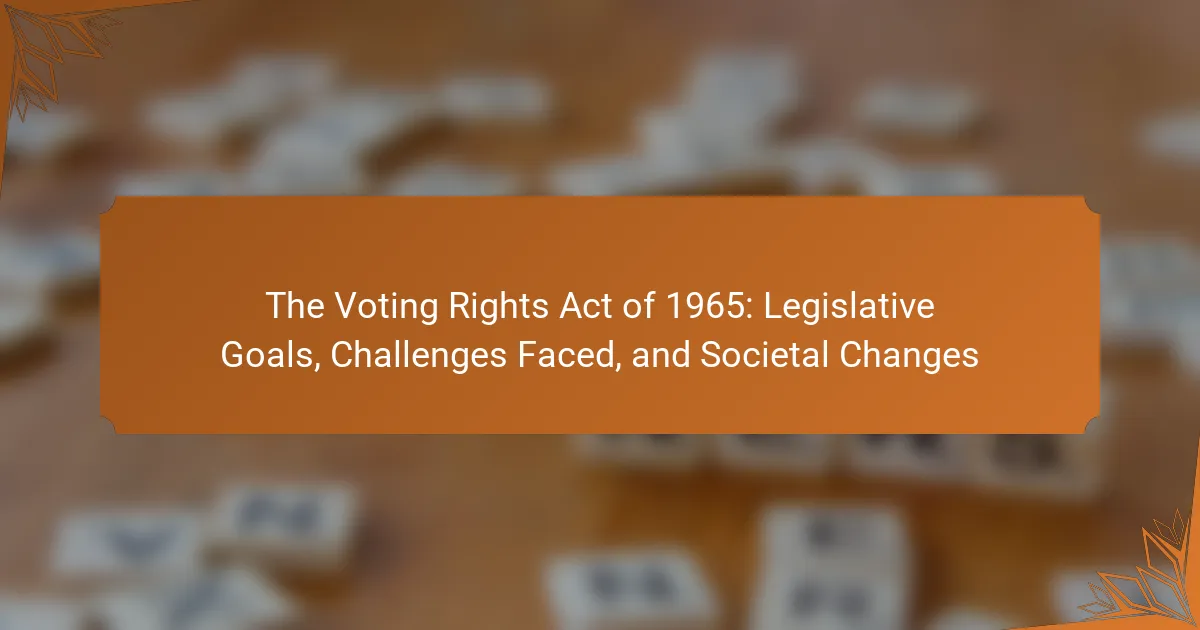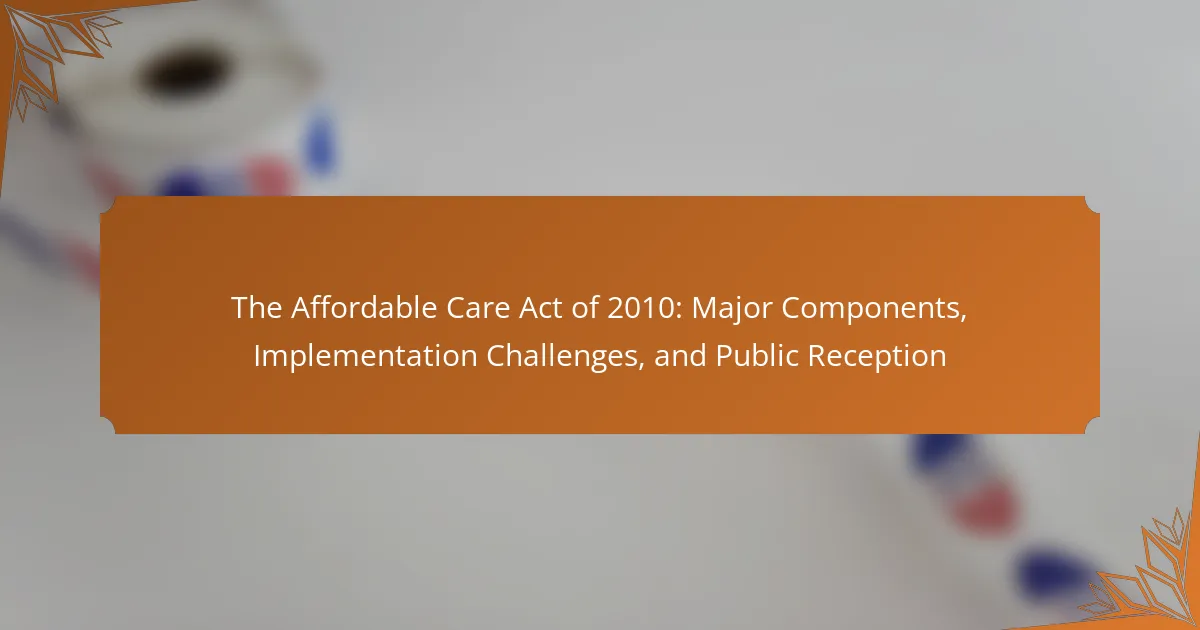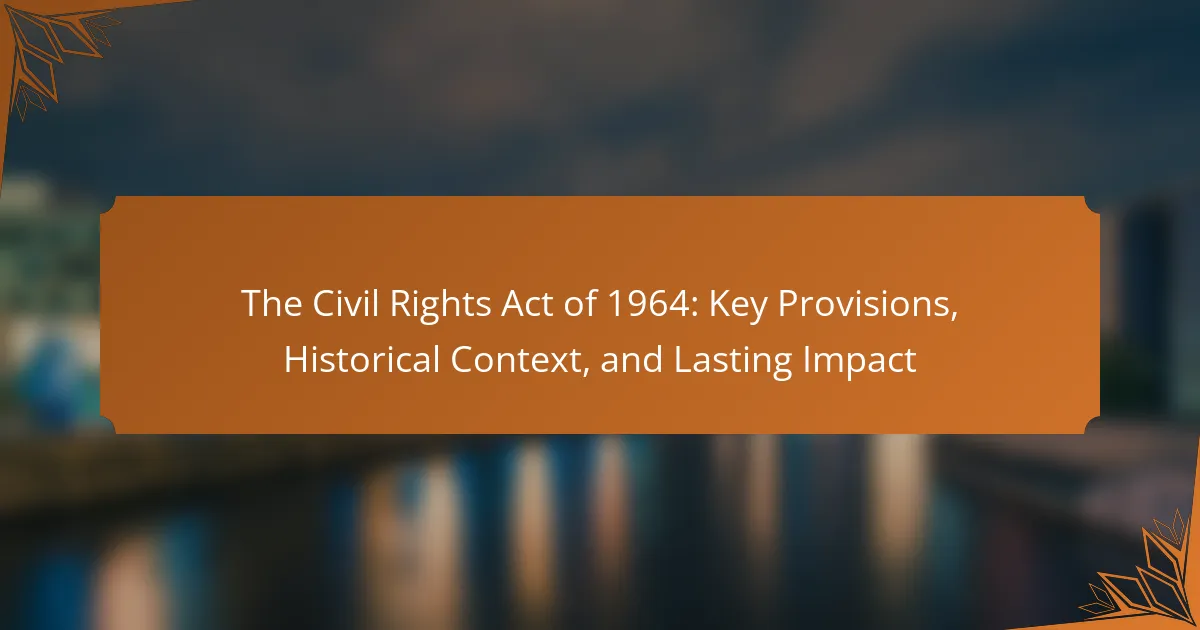The GI Bill of 1944, officially known as the Servicemen’s Readjustment Act, provided essential benefits to returning World War II veterans to support their transition into civilian life. Key features of the GI Bill included funding for education, low-interest home loans, and unemployment compensation, significantly increasing access to higher education for millions of veterans. By facilitating educational opportunities and home ownership, the GI Bill contributed to the expansion of the American middle class and stimulated post-war economic growth. It is recognized as one of the most impactful pieces of legislation in American history, with over 7.8 million veterans benefiting from its provisions, leading to long-term effects such as increased educational attainment and home ownership rates.
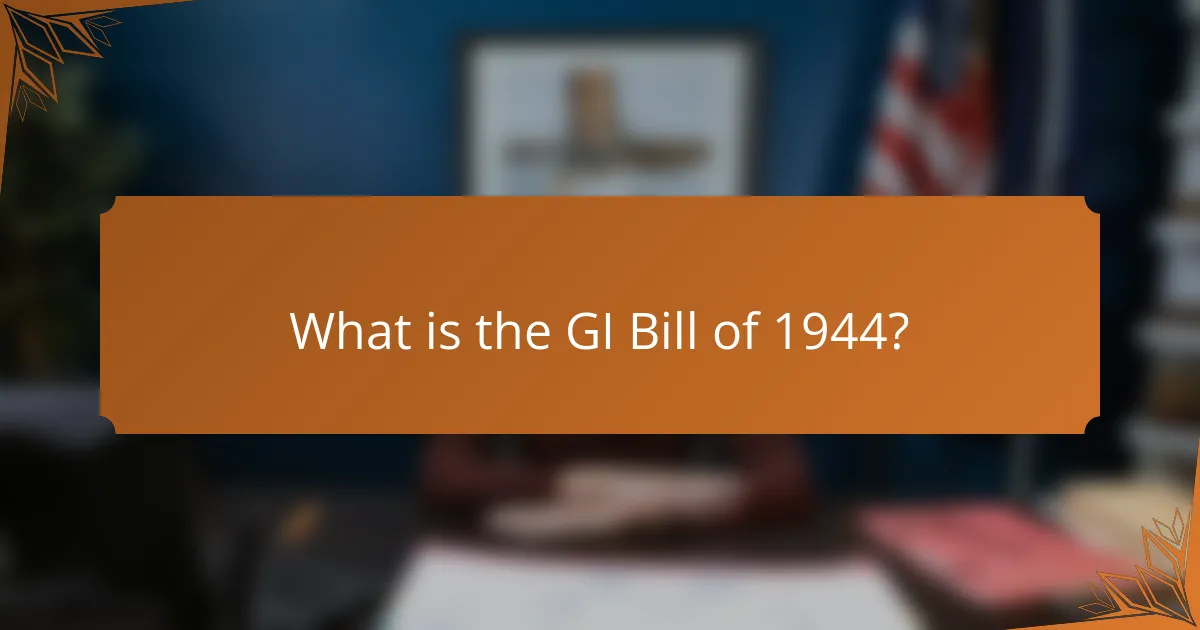
What is the GI Bill of 1944?
The GI Bill of 1944, officially known as the Servicemen’s Readjustment Act, provided various benefits to returning World War II veterans. It aimed to facilitate their reintegration into civilian life. Key provisions included funding for education, low-interest home loans, and unemployment compensation. The bill significantly increased access to higher education for millions of veterans. Approximately 7.8 million veterans utilized educational benefits under the GI Bill. This legislation contributed to the expansion of the American middle class in the post-war era. The GI Bill is considered one of the most successful pieces of legislation in American history. Its long-term effects include increased home ownership and higher education attainment among veterans.
How did the GI Bill of 1944 come into existence?
The GI Bill of 1944, officially known as the Servicemen’s Readjustment Act, came into existence due to the need to support returning World War II veterans. In the early 1940s, policymakers recognized the challenges veterans would face reintegrating into civilian life. The bill aimed to provide educational benefits, housing assistance, and unemployment compensation. It was signed into law by President Franklin D. Roosevelt on June 22, 1944. The legislation was a response to the economic conditions of the time, which included fears of a post-war recession. The GI Bill significantly transformed American society by enabling millions of veterans to pursue higher education and home ownership. By 1956, over 7.8 million veterans had utilized the benefits, demonstrating its profound impact on the economy and workforce.
What historical context led to the creation of the GI Bill?
The GI Bill was created in response to the needs of returning World War II veterans. After the war, millions of soldiers needed support to reintegrate into civilian life. The U.S. government recognized the potential for economic disruption if veterans could not find jobs or education. In 1944, the Servicemen’s Readjustment Act was enacted, providing benefits to help veterans. These benefits included funding for education, housing, and unemployment. The intent was to prevent a post-war recession and promote economic growth. Historical data shows that the GI Bill significantly increased college enrollment and home ownership among veterans. This legislation has had lasting impacts on American society and the economy.
Who were the key figures involved in its development?
The key figures involved in the development of the GI Bill of 1944 include President Franklin D. Roosevelt and Senator Harry W. Colmery. Franklin D. Roosevelt was instrumental in advocating for veterans’ benefits during and after World War II. Senator Harry W. Colmery, a veteran himself, played a crucial role in drafting the bill. Their collaboration helped shape the legislation that provided educational benefits to millions of veterans. Additionally, the American Legion was influential in lobbying for the bill’s passage, emphasizing the need for support for returning servicemen. These contributions collectively led to the establishment of the GI Bill, which has had lasting impacts on American society.
What are the main components of the GI Bill of 1944?
The main components of the GI Bill of 1944 include education benefits, housing assistance, and unemployment compensation. Education benefits cover tuition and fees for veterans attending college or vocational schools. The bill also provides a living stipend to help cover housing costs while veterans study. Unemployment compensation offers financial support for veterans who struggle to find work after returning from military service. These components aimed to facilitate the reintegration of veterans into civilian life. The GI Bill significantly increased the number of veterans who attended college, contributing to a more educated workforce. It also helped stimulate the post-war economy by enabling home purchases through low-interest loans.
What types of educational benefits does the GI Bill provide?
The GI Bill provides several types of educational benefits. These include tuition coverage for college, university, vocational, and technical schools. It also offers a monthly housing allowance for enrolled students. Additionally, the GI Bill provides a stipend for books and supplies. Eligible veterans can access these benefits for various degree programs. The Post-9/11 GI Bill specifically covers the full cost of in-state tuition at public colleges. It also includes a transfer option for service members to pass benefits to family members. Since its inception in 1944, the GI Bill has significantly increased access to higher education for veterans.
How does the GI Bill support housing and living expenses for veterans?
The GI Bill provides financial assistance for housing and living expenses to veterans. This support includes a monthly housing allowance based on the cost of living in the area where the veteran attends school. The allowance is available to veterans enrolled in educational programs. Additionally, the GI Bill covers housing costs for veterans attending training programs or apprenticeships. According to the U.S. Department of Veterans Affairs, eligible veterans can receive benefits that cover tuition and fees, along with a living stipend. This financial aid helps veterans transition to civilian life by alleviating housing costs. The GI Bill has significantly contributed to the economic stability of millions of veterans since its inception.
What impact did the GI Bill of 1944 have on American society?
The GI Bill of 1944 significantly transformed American society. It provided educational benefits to millions of World War II veterans. This led to a dramatic increase in college enrollment rates. By 1947, over 1.5 million veterans were attending college. The bill also offered low-interest home loans, boosting the housing market. This contributed to the post-war economic boom. The legislation helped reduce unemployment rates among veterans. It also facilitated the growth of the American middle class. Overall, the GI Bill reshaped the educational landscape and economic structure of the nation.
How did the GI Bill influence post-war education levels in the U.S.?
The GI Bill significantly increased post-war education levels in the U.S. It provided financial assistance for veterans to pursue higher education. This led to a dramatic rise in college enrollment. In 1940, only about 15% of high school graduates attended college. By 1950, this number had soared to over 50%. The bill covered tuition and fees, making education accessible for many. It also offered living stipends, which supported veterans while they studied. The increased educational attainment improved job prospects for veterans. By the 1960s, the U.S. workforce had a more educated population, contributing to economic growth.
What role did the GI Bill play in shaping the American middle class?
The GI Bill significantly contributed to the formation of the American middle class. It provided educational benefits to returning World War II veterans. This access to education led to higher levels of employment and income. Many veterans used the bill to attend college or vocational training. The increased education levels resulted in better job opportunities. Home loan guarantees enabled veterans to purchase homes. This homeownership contributed to wealth accumulation for many families. As a result, the GI Bill helped create a stable middle class in post-war America.

What educational benefits does the GI Bill of 1944 offer?
The GI Bill of 1944 offers various educational benefits to veterans. It provides financial assistance for tuition and fees for higher education. Veterans can receive funding for vocational training and apprenticeships. The bill also covers housing allowances for enrolled students. Additionally, it includes funds for books and supplies. Over 7 million veterans have benefited from these educational provisions since its enactment. The GI Bill significantly increased college enrollment rates among veterans. This legislation contributed to a more educated workforce in the post-war economy.
How do educational benefits vary under the GI Bill?
Educational benefits under the GI Bill vary based on service duration and enrollment type. Benefits include tuition coverage, housing stipends, and funds for books. The Post-9/11 GI Bill offers comprehensive benefits for veterans who served on active duty after September 10, 2001. Eligible veterans can receive full tuition for public colleges and universities. For private or foreign institutions, there is a cap on tuition reimbursement. The Montgomery GI Bill, available for those who served before 2001, provides a monthly education benefit based on service time. Additionally, benefits can differ based on enrollment in degree programs, non-college degree programs, apprenticeships, or on-the-job training. Each program has specific eligibility criteria and funding limits.
What are the eligibility requirements for educational benefits?
To be eligible for educational benefits under the GI Bill of 1944, individuals must meet specific criteria. These requirements include having served a minimum period in the military, typically 90 days of active duty. Additionally, veterans must have been honorably discharged from the service. The benefits are available to those who have completed a qualifying period of service, which varies based on the length of active duty. Furthermore, applicants must enroll in an approved educational program. This ensures that they can access the benefits for tuition, housing, and other educational expenses.
How can veterans access these educational benefits?
Veterans can access educational benefits through the GI Bill by applying online through the U.S. Department of Veterans Affairs (VA) website. They need to provide necessary documentation, including their service records. Veterans may also apply in person at a regional VA office. Additionally, they can contact their school’s financial aid office for assistance with the application process. The VA typically processes applications within 30 days. Eligible veterans can receive funding for tuition, housing, and other educational expenses. The GI Bill has supported millions of veterans since its enactment in 1944.
What types of educational institutions are covered by the GI Bill?
The GI Bill covers a variety of educational institutions. These include colleges, universities, vocational schools, and technical training institutes. Additionally, it encompasses community colleges and non-college degree programs. The institutions must be accredited and approved by the Department of Veterans Affairs. Eligible programs can lead to degrees, certificates, or other recognized credentials. This broad coverage helps veterans access diverse educational opportunities.
How does the GI Bill support vocational training and apprenticeships?
The GI Bill supports vocational training and apprenticeships by providing financial assistance for education and training programs. This includes funding for tuition, fees, and supplies necessary for vocational courses. Eligible veterans can access benefits that cover the costs of various training programs, including apprenticeships. The program aims to enhance employability and skill development for veterans transitioning to civilian careers. As of 2021, approximately 1.5 million veterans utilized these benefits for vocational training. The GI Bill has significantly contributed to workforce development by enabling veterans to gain practical skills in high-demand fields.
What options are available for online education under the GI Bill?
The GI Bill provides various options for online education. Eligible veterans can attend online degree programs at accredited colleges and universities. They can also enroll in non-college degree programs, such as vocational training or apprenticeships. The GI Bill covers tuition and fees for these programs, up to the maximum limits set by the Department of Veterans Affairs. Additionally, veterans can access funding for housing and books while pursuing online education. This flexibility allows veterans to balance education with work and family commitments.
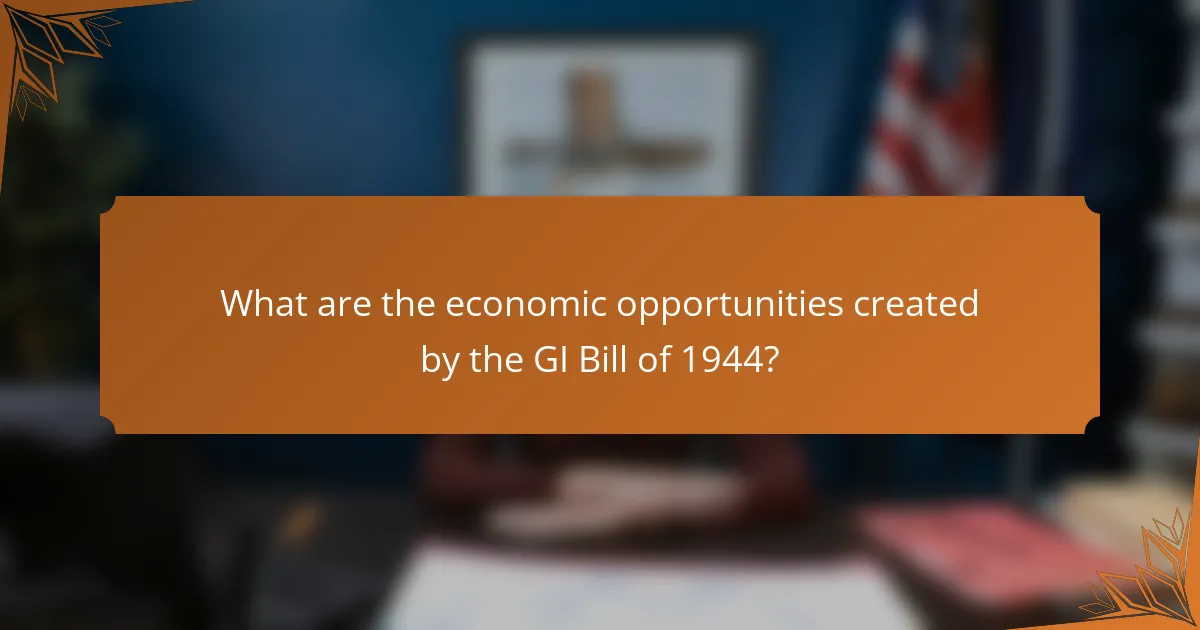
What are the economic opportunities created by the GI Bill of 1944?
The GI Bill of 1944 created significant economic opportunities for veterans. It provided funding for education and training, enabling millions to pursue higher education. This led to a more skilled workforce, enhancing productivity. The bill also offered low-interest home loans, facilitating home ownership. Home ownership stimulated the housing market and related industries. Additionally, it supported small business loans, encouraging entrepreneurship among veterans. Overall, the GI Bill contributed to post-war economic expansion in the United States. By 1956, over 7.8 million veterans had used the education benefits, illustrating its widespread impact.
How has the GI Bill contributed to economic growth in the U.S.?
The GI Bill has significantly contributed to economic growth in the U.S. by facilitating education and home ownership for millions of veterans. Since its enactment in 1944, it has provided financial assistance for education, vocational training, and housing. This support helped veterans transition to civilian life, increasing their employability.
Higher education levels among veterans led to a more skilled workforce. This skilled workforce contributed to post-war economic expansion, particularly in the manufacturing and service sectors. The GI Bill also stimulated the housing market by making home loans accessible to veterans.
Between 1944 and 1956, over 2 million veterans purchased homes with GI Bill benefits. This surge in home ownership boosted construction and related industries. Studies indicate that the GI Bill’s impact on education and housing contributed to the creation of a robust middle class in America.
The economic benefits of the GI Bill are evident in the increased GDP and overall prosperity during the latter half of the 20th century. In summary, the GI Bill has been a cornerstone of economic growth in the U.S. through its investment in education and housing for veterans.
What industries saw significant growth due to the GI Bill?
The GI Bill significantly boosted the construction, education, and healthcare industries. The construction sector expanded due to increased demand for housing, as veterans sought homes after returning from service. The education industry grew with millions of veterans enrolling in colleges and vocational schools, leading to a surge in educational institutions. The healthcare industry also saw growth as veterans required medical services and support, prompting the establishment of new facilities and programs. These industries collectively benefited from the financial support provided by the GI Bill, which facilitated access to education and home ownership for returning servicemen and women.
How did the GI Bill impact workforce development and job training?
The GI Bill significantly impacted workforce development and job training by providing veterans with access to education and vocational training. It facilitated the transition of millions of servicemen and women into civilian careers. The bill offered financial support for college tuition, vocational training, and apprenticeships. This led to a more skilled workforce in various industries.
By 1956, over 7.8 million veterans had utilized the education benefits. The increased education levels among veterans contributed to economic growth in the post-war era. Studies show that those who benefited from the GI Bill had higher incomes compared to non-veterans. The GI Bill also helped establish a culture of lifelong learning and upskilling in the workforce.
What long-term economic effects can be traced back to the GI Bill?
The GI Bill has led to significant long-term economic effects. It increased access to higher education for millions of veterans. This resulted in a more educated workforce. The bill contributed to the expansion of the middle class in the United States. Home ownership rates increased due to benefits for purchasing homes. The economy experienced growth as veterans entered the workforce. Studies show that the GI Bill generated approximately $7 in economic returns for every $1 spent. This long-term impact has shaped the American economy for decades.
How has home ownership among veterans changed over time due to the GI Bill?
Home ownership among veterans has significantly increased over time due to the GI Bill. The GI Bill, enacted in 1944, provided veterans with access to low-interest home loans without the need for a down payment. This financial support made home ownership more attainable for millions of veterans returning from World War II.
By 1950, approximately 49% of veterans owned homes, a sharp increase from pre-war levels. The trend continued, with home ownership rates among veterans rising steadily throughout the decades. In the 1970s, around 80% of veterans owned homes, highlighting the long-term impact of the GI Bill on housing stability.
Research indicates that the GI Bill has contributed to the growth of the American middle class by facilitating home ownership. This has had lasting effects on wealth accumulation and community stability for veterans and their families. The GI Bill’s provisions have been crucial in shaping the landscape of home ownership for veterans in the United States.
What evidence is there of increased income levels among GI Bill beneficiaries?
GI Bill beneficiaries experience increased income levels compared to non-beneficiaries. Studies show that veterans using the GI Bill have higher median earnings. For instance, the National Bureau of Economic Research found that GI Bill recipients earn approximately 15% more than their peers without the benefit. Additionally, a report by the U.S. Department of Veterans Affairs indicated that 90% of GI Bill graduates secure employment after graduation. These statistics illustrate the positive economic impact of the GI Bill on beneficiaries’ income levels.
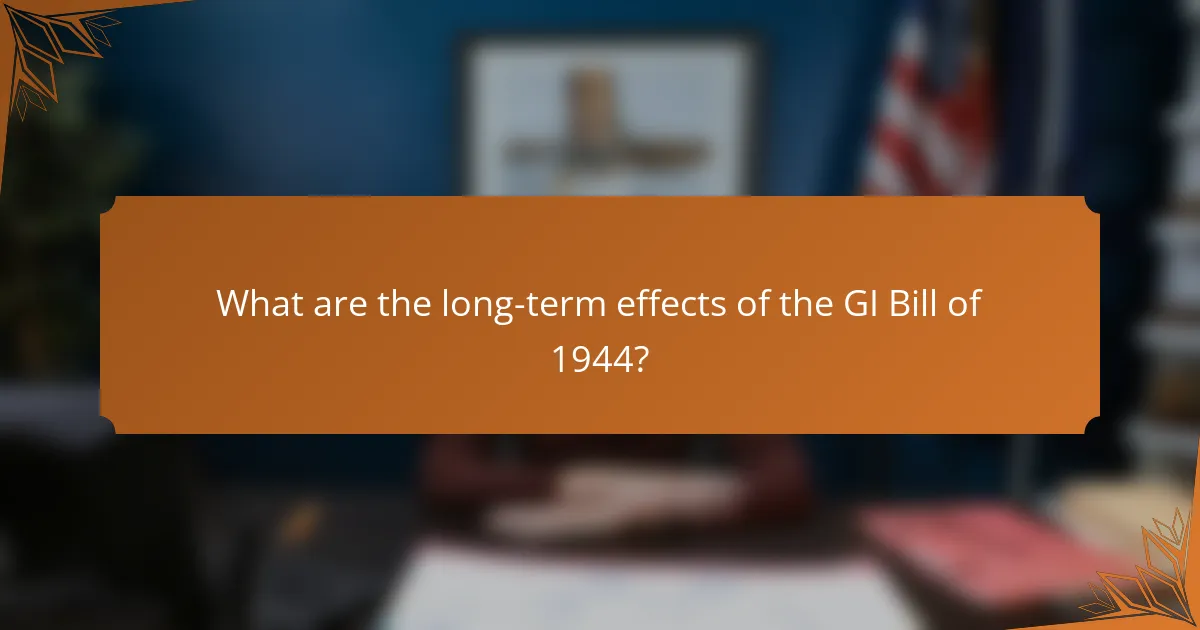
What are the long-term effects of the GI Bill of 1944?
The long-term effects of the GI Bill of 1944 include increased educational attainment and economic growth. The bill provided veterans with access to higher education, resulting in a more educated workforce. This educational boost contributed to the post-war economic expansion in the United States.
Statistically, millions of veterans utilized the benefits, leading to significant increases in college enrollment. By 1947, over 49% of veterans were enrolled in college or vocational programs. The GI Bill also facilitated home ownership for veterans, which contributed to the growth of the American middle class.
Home loans backed by the GI Bill allowed veterans to purchase homes at unprecedented rates. This increased home ownership rates from 43% in 1940 to nearly 60% by 1960. The economic impact of the GI Bill is estimated to have generated over $7 trillion in economic output through its provisions.
Overall, the GI Bill transformed American society by promoting education, home ownership, and economic prosperity for generations.
How has the GI Bill shaped the educational landscape in America?
The GI Bill has significantly transformed the educational landscape in America. It provided financial assistance for veterans to pursue higher education. This led to a dramatic increase in college enrollment after World War II. In 1947, around 49% of veterans utilized the benefits. The bill also facilitated access to vocational training and home ownership. This contributed to the expansion of the middle class. It reduced the financial barriers to education for millions of Americans. The GI Bill has been credited with shaping the modern American workforce.
What trends in higher education can be linked to the GI Bill’s influence?
The GI Bill significantly increased enrollment in higher education. It provided financial assistance to millions of veterans after World War II. This led to a surge in college attendance rates, particularly among non-traditional students. The bill also contributed to the expansion of community colleges and vocational training programs. Additionally, it played a role in diversifying the student population. More women and minorities accessed higher education due to the opportunities created by the GI Bill. The long-term economic impact included a more educated workforce. This workforce contributed to post-war economic growth and innovation in the United States.
How has the GI Bill affected generational access to education?
The GI Bill has significantly increased generational access to education. It provided financial support for veterans to pursue higher education. This support included tuition coverage and a living stipend. As a result, millions of veterans attended college and advanced their education. The bill led to higher educational attainment in families. Studies show that children of educated parents are more likely to succeed academically. This cycle of education has contributed to greater economic mobility. The GI Bill’s long-term effects include a more educated workforce and reduced poverty rates.
What social changes have occurred as a result of the GI Bill?
The GI Bill has led to significant social changes in American society. It facilitated the education of millions of veterans, increasing their access to higher education. This education boost contributed to a more skilled workforce. The bill also enabled veterans to purchase homes, leading to suburban expansion. This homeownership shift transformed the American landscape and promoted the middle class. Additionally, the GI Bill helped reduce poverty rates among veterans. It played a crucial role in fostering economic growth in the post-war era. These changes collectively reshaped American social structures and contributed to the rise of a prosperous, educated society.
How has the GI Bill contributed to racial and gender equity in education?
The GI Bill has significantly contributed to racial and gender equity in education by providing access to higher education for previously marginalized groups. Initially, many veterans, particularly African Americans and women, faced barriers to utilizing these educational benefits. However, over time, the GI Bill facilitated increased enrollment of diverse populations in colleges and universities. For instance, by the 1970s, the number of Black veterans attending college rose dramatically due to the bill. Additionally, the inclusion of women in the workforce and their pursuit of higher education expanded as a result of these benefits. Studies indicate that the GI Bill helped to close educational attainment gaps, contributing to improved economic opportunities for marginalized groups. Overall, the GI Bill played a crucial role in promoting greater equity in educational access and outcomes.
What role did the GI Bill play in the integration of veterans into civilian life?
The GI Bill significantly facilitated the integration of veterans into civilian life. It provided educational benefits, enabling millions of veterans to access higher education. This education improved their job prospects and earning potential. The bill also offered low-interest home loans, promoting home ownership among veterans. Home ownership contributed to stable families and communities. Additionally, the GI Bill included unemployment benefits, providing financial support during the transition. By addressing these key areas, the GI Bill helped veterans successfully reintegrate into society. Historical data shows that over 7 million veterans utilized the GI Bill in its first decade, leading to substantial economic growth.
What practical tips can veterans follow to maximize their GI Bill benefits?
Veterans can maximize their GI Bill benefits by understanding eligibility and exploring all available options. They should research different educational programs that qualify for benefits. Utilizing the full extent of the benefits, including housing and book stipends, is crucial. Veterans should also keep track of their benefits usage to avoid exhausting them prematurely. Consulting with a VA representative can provide tailored advice specific to their situation. Additionally, taking advantage of transfer options to family members can enhance the value of their benefits. Engaging with veteran support groups can offer valuable insights and shared experiences. Finally, staying informed about any changes to the GI Bill regulations ensures they are making the most of their entitlements.
The GI Bill of 1944, officially known as the Servicemen’s Readjustment Act, provided essential educational benefits, economic opportunities, and support for millions of World War II veterans. Key provisions included funding for education, low-interest home loans, and unemployment compensation, significantly increasing access to higher education and home ownership. The legislation played a crucial role in shaping the American middle class and contributed to post-war economic growth. This article examines the historical context, main components, long-term effects, and the impact of the GI Bill on American society, including workforce development and social changes related to racial and gender equity in education.

